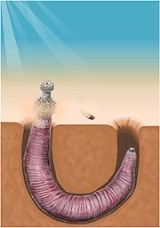
Ottoia
Encyclopedia
Ottoia is the most abundant priapulid of the Cambrian
Burgess Shale
formation of British Columbia
. It is a stem-group priapulid
worm that averaged about 80 mm in length.
.
The spines on the proboscis of Ottoia have been interpreted as teeth used to capture prey. Its mode of life is uncertain, but it is thought to have been an active burrower, moving through the sediment after prey, and is believed to have lived within a U-shaped burrow that it constructed in the substrate. From that place of relative safety, it could extend its proboscis in search of prey. Gut contents show that this worm was a predator, often feasting on the hyolithid
Haplophrentis (a shelled animal similar to mollusks), generally swallowed them head-first. They also show evidence of cannibalism
, which is common in priapulids today.
Ottoia is also known from Middle Cambrian deposits in Utah and Spain, and Nevada.
Cambrian
The Cambrian is the first geological period of the Paleozoic Era, lasting from Mya ; it is succeeded by the Ordovician. Its subdivisions, and indeed its base, are somewhat in flux. The period was established by Adam Sedgwick, who named it after Cambria, the Latin name for Wales, where Britain's...
Burgess Shale
Burgess Shale
The Burgess Shale Formation, located in the Canadian Rockies of British Columbia, is one of the world's most celebrated fossil fields, and the best of its kind. It is famous for the exceptional preservation of the soft parts of its fossils...
formation of British Columbia
British Columbia
British Columbia is the westernmost of Canada's provinces and is known for its natural beauty, as reflected in its Latin motto, Splendor sine occasu . Its name was chosen by Queen Victoria in 1858...
. It is a stem-group priapulid
Priapulida
Priapulida is a phylum of marine worms. They are named for their extensible spiny proboscis, which, in some species, may have a shape like that of a human penis...
worm that averaged about 80 mm in length.
Ecology
Ottoia was a burrower that hunted prey with its eversible proboscis. It also appears to have scavenged on dead organisms such as the arthropod SidneyiaSidneyia
Sidneyia is an extinct arthropod known from fossils found in the Cambrian-age Burgess Shale formation of British Columbia. -General description:...
.
The spines on the proboscis of Ottoia have been interpreted as teeth used to capture prey. Its mode of life is uncertain, but it is thought to have been an active burrower, moving through the sediment after prey, and is believed to have lived within a U-shaped burrow that it constructed in the substrate. From that place of relative safety, it could extend its proboscis in search of prey. Gut contents show that this worm was a predator, often feasting on the hyolithid
Hyolitha
Hyolitha are enigmatic animals with small conical shells known from the Palaeozoic Era.-Shell morphology:The calcareous shells have a cover and two curved supports known as helens. Most are one to four centimeters in length and are triangular or elliptical in cross section...
Haplophrentis (a shelled animal similar to mollusks), generally swallowed them head-first. They also show evidence of cannibalism
Cannibalism
Cannibalism is the act or practice of humans eating the flesh of other human beings. It is also called anthropophagy...
, which is common in priapulids today.
Preservation
Because of its bottom living habit and the location of the Burgess Shale site at the foot of a high limestone reef, one may presume the relative immobility of Ottoia placed it in danger of being carried away and/or buried by any underwater mud avalanche from the cliff top. This may explain why it remains one of the more abundant specimens of the Burgess Shale fauna.Distribution
At least 1000 Burgess Shale specimens are known in the UNSM collections alone, in addition to the ROM collections and hundreds of specimens elsewhere.Ottoia is also known from Middle Cambrian deposits in Utah and Spain, and Nevada.

